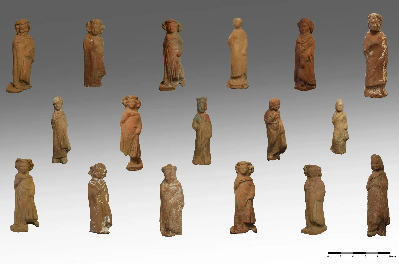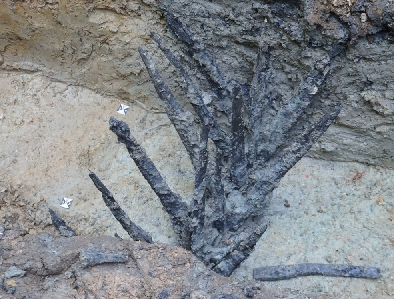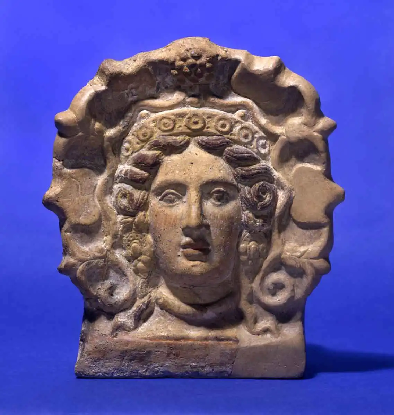3000-year-old untouched burial of ‘charioteer’ discovered in Siberia
Archaeologists in Siberia have discovered a remarkably well-preserved burial of a 3000-year-old “charioteer” untouched by looters. The burial was found in the Altai Mountains region, known for its rich archaeological finds.
The burial chamber, made of stone slabs, contained the remains of a man believed to be in his 30s or 40s. He was found in a seated position, surrounded by a variety of artifacts, including weapons, jewelry, and tools. The most striking find was a chariot-like wooden construction, which is believed to have been used for ceremonial purposes.
Experts believe that the man was a high-ranking individual in the ancient society, given the elaborate burial and the presence of the chariot. The charioteer’s body was adorned with intricate tattoos, which are expected to provide insights into the ancient art form.
The remains of horses were also found near the burial site, suggesting that they were sacrificed as part of the burial ritual. The discovery of the chariot and horses further indicates that the individual held an important position, possibly as a warrior or a religious leader.

The burial provides a rare opportunity to study the material culture and social structure of the ancient society that inhabited the Altai Mountains region. The well preserved artifacts and the untouched nature of the burial allow archaeologists to gain a unique glimpse into the daily life, beliefs, and customs of the people living in Siberia thousands of years ago.
The discovery holds significant historical and cultural value. It adds to our understanding of the region’s ancient civilizations and sheds light on the use of chariots and their symbolic importance in society at that time. The tattoos found on the charioteer’s body also provide valuable insight into ancient tattooing techniques and their significance in prehistoric societies.
The excavation and analysis of the burial will continue in the coming months and years, with hopes of uncovering more information about the charioteer’s life and the people who buried him. It is expected that further research and studies will shed more light on the context, customs, and rituals associated with the burial, providing a deeper understanding of ancient Siberian cultures.
2,000 Ancient Figurines Unearthed on Greek Island
In a major archaeological discovery, over 2,000 ancient figurines have been unearthed on the Greek island of Keros. The find has been described as one of the most important Aegean archaeological sites of the last decades. The figures all date to between 2,500 and 2,000 BC, making them the earliest known representations of humans in the Aegean Sea region. The figurines were discovered in a field in the center of the easternmost part of the Greek island, which until recently was one of the least explored archaeological sites in the area. The amazing collection of figurines was made up of over 2,000 male and female figures, as well as animals and plants. These items were made out of marble, terracotta, and bronze and were all found in the same location, which archaeologists have concluded was an ancient cemetery. The figures all bear striking similarities, likely indicating they were created by the same group of people.

The fact that they were found in the same location and at the same time points to the fact that they may have been part of a larger ritualistic practice. This discovery has shed new light on the history of the Aegean Sea and the islands scattered around it. It has given archaeologists insight into the beliefs, customs and practices of people who lived in this region centuries ago. The archaeological dig is one of the first of its kind in this region and it will help researchers to better understand the culture of the ancient people who lived in this part of the world. This find is a reminder of the rich and vibrant history that lies beneath the surface of the Mediterranean – a region that has birthed some of the most famous civilizations in history. By uncovering these figurines, archaeologists have opened a door to a past that has been shrouded in mystery for thousands of years.
Archaeologists Discover Wooden Spikes Described by Julius Caesar
Archaeologists recently reported a stunning discovery; wooden spikes mentioned in Julius Caesar’s “Gallic War” book that were thought to have gone missing for centuries. The discovery was made in a site in northwest France near the coastal city of Brittany. In his book, Julius Caesar wrote about how the Gauls used pointed wooden stakes to prevent the entry of the Roman navy into their harbors. It was a subject of much speculation as no one was able to confirm whether or not Caesar’s account was historically accurate. It was believed that the wooden posts had disappeared with the passage of time. However, recent archaeological excavations near the harbor of Port d’Erquy in the Côtes-d’Armor region of northwest France re-wrote the history. Archaeologists found nearly 200 wooden stakes located on the sea bed.The wooden posts are about two meters high and are said to pre-date the Christian era.The stakes were made of ash, and it is believed that the timber was cut from local forests.

The new discovery confirms that the method mentioned by Julius Caesar was in use by the Gauls during the times. Archaeologists suggest that the wooden posts may have been hidden in the sea bed due to its protective effects from the ocean’s tides and winds. It is also possible that the Gauls placed the posts because of a change in military strategy among other reasons. In addition, experts believe that the discovery also serves as proof of ancient maritime engineering and craftsmanship. It is difficult to achieve such precision in construction without the use of metal tools, so the craftsmanship involved must have been quite impressive indeed. All in all, the incredible discovery of wooden spikes made by the ancient Gauls rewrites the history of Julius Caesar’s Gallic War and serves as evidence of their ancient maritime engineering and craftsmanship. It is a fascinating look into the past and the archaeologists involved are sure to gain much knowledge from this find.
The Archaeological Story of the Etruscan People
The Etruscans were an ancient civilization that lived in what is now central Italy. They flourished from around 900 to 100 BC, before being assimilated into Roman society. The Etruscans had a strong tradition of art, architecture, religion, and trade. They were also renowned as warriors, sailors, and merchants. The origins of the Etruscans are still debated amongst scholars. According to the traditional belief, the Etruscans were of mysterious and unknown origin, possibly descended from a non-Indo-European people. However, modern theories suggest that they could have descended from one or more foreign peoples such as the Anatolian, the Scythian, or the Minoan. The Etruscans had a distinct and advanced art and architecture style, characterized by the use of terracotta and arches. They were also renowned for their bronze sculptures and production of ceramics. Well preserved examples of their art are located in many Italian cities, including the Vatican Museums and the Etruscan Museum in Rome.

The Etruscans had an advanced religion. They believed in a pantheon of many gods, conducting elaborate ceremonies and rituals to honor them. They also believed in a belief in the afterlife, and relied heavily on divination and concern for the human soul. Furthermore, they believed in the power of fate and consulted haruspices (priests who read entrails) for advice on important matters. The Etruscans had an extensive trading network. They traded with peoples from the Mediterranean basin, establishing trading links that reached as far as the British Isles and the Middle East. The Etruscans were especially renowned for their wine and olives. Though the Etruscan civilization eventually fell to the Roman Empire, its legacy is still visible. Its contribution to Italian culture and art is remarkable, and the Etruscan language is still spoken in parts of Italy today. Furthermore, its mythology and religious beliefs are often visible in the art and symbols of Rome. Though the Etruscans are often overshadowed by their Roman successors, their remarkable culture, art, and religion will always be remembered.
Archaeologists Discover “Geometric Miracle”
Archaeologists have recently discovered a “geometric miracle” while searching for Cleopatra’s tomb in Alexandria, Egypt. The discovery was made by a team of archaeologists led by archaeologist and Egyptologist Zahi Hawass. The team was searching for the tomb of the last Pharaoh of Ancient Egypt, Cleopatra, in the Kom el-Dikka area of Alexandria. After excavating the area, they discovered a series of tunnels and chambers that had been cut into the bedrock. Inside these tunnels, the team discovered a unique geometric pattern. The pattern consists of a series of circles and squares that fit together perfectly, forming a perfect circle. The team believes that this geometric pattern was created by the ancient Egyptians in order to create an astrological chart to chart the movements of the stars.

This chart would then have been used to predict the future and help the Egyptians make decisions about the best times to conduct certain ceremonies and rituals. This discovery is important for a number of reasons. Firstly, it provides further evidence of the advanced astronomical knowledge possessed by the ancient Egyptians. Secondly, it gives us an insight into the complex religious and spiritual beliefs of the ancient Egyptians. Finally, it demonstrates that ancient Egyptians were capable of creating complex mathematical and geometric patterns in order to understand the universe around them. The discovery of this unique geometric pattern is an incredible find and adds to our understanding of the ancient Egyptians and their advanced knowledge of astronomy. It is likely that further discoveries will be made in the future as the team continues to explore the area in search of Cleopatra’s tomb. Whatever the outcome, this discovery is sure to provide us with an insight into the fascinating culture and beliefs of the ancient Egyptians.